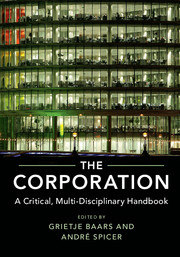Book contents
- Frontmatter
- Contents
- List of Contributors
- Acknowledgements
- Introduction: Why the Corporation?
- PART I DISCIPLINARY OVERVIEWS
- PART II INTERDISCIPLINARY THEMATIC CHAPTERS
- 1 The Evolution of the Corporate Form
- 2 The Multinational Corporate Group
- 3 The Financialization of the Corporation
- 4 Corporate Value Chains
- 5 Corporate Citizenship
- 6 The Corporation and Crime
- 7 The Corporation and Ideology
- 8 Corporation and Communities
- 9 Corporations and Resistance
- a Organizing in the Nervous System: Global Trade Unions and Global Production Networks
- b Rethinking Workplace Resistance: Between Revolt and Co-Optation
- c Anarchist versus Corporate Ethics
- 10 Alternatives to the Corporation
- Index
- References
b - Rethinking Workplace Resistance: Between Revolt and Co-Optation
from 9 - Corporations and Resistance
Published online by Cambridge University Press: 31 March 2017
- Frontmatter
- Contents
- List of Contributors
- Acknowledgements
- Introduction: Why the Corporation?
- PART I DISCIPLINARY OVERVIEWS
- PART II INTERDISCIPLINARY THEMATIC CHAPTERS
- 1 The Evolution of the Corporate Form
- 2 The Multinational Corporate Group
- 3 The Financialization of the Corporation
- 4 Corporate Value Chains
- 5 Corporate Citizenship
- 6 The Corporation and Crime
- 7 The Corporation and Ideology
- 8 Corporation and Communities
- 9 Corporations and Resistance
- a Organizing in the Nervous System: Global Trade Unions and Global Production Networks
- b Rethinking Workplace Resistance: Between Revolt and Co-Optation
- c Anarchist versus Corporate Ethics
- 10 Alternatives to the Corporation
- Index
- References
Summary
Viewing the capitalist corporation as an efficient machine, as the epiphany of instrumental rationality, is as old as the corporation itself and can be traced to all classics of social science including Adam Smith, Karl Marx, Max Weber, Émile Durkheim, and Jürgen Habermas. The continual decrease of production costs and the ever-evolving management of workers and their performance seem to warrant maximal output with minimum output. But is the corporation really as rational as we would like to believe? And has the promise of managing work to the utmost ever succeeded?
Consider the phenomenon of empty labour, or private activities during working hours. According to the surveys that have been done on empty labour, we are today spending an average of 1.5 to 3 hours a day slacking off at work. Sometimes this slacking is due to inevitable periods of wait and downtime, but much of it stems from the active withdrawal of the worker. Employees may avoid work because they find it strenuous, meaningless, a waste of time, or because they are too bored to even care (Paulsen, 2014). Some of the most extreme examples include a British insurance employee who for six years did no more than the equivalence of six months’ work (Bolchover, 2005).
Consider the widespread practice of workplace theft. According to The Global Retail Barometer, American retail staff are out-stealing thieves coming from outside the firms. Employees account for 43 per cent of lost revenues, whereas shoplifters account for 37 per cent. Most employee theft takes place by the cash register through cancelations of transactions that ought not to be cancelled, or through the issuing of illicit refunds. In 2013, this particular type of employee theft made up an estimated lost in US retail revenue of $18 billion (Pinsker, 2014). Needless to say, there are other types of employee theft taking place in all trades and at all organization levels (see especially Mars, 1982).
- Type
- Chapter
- Information
- The CorporationA Critical, Multi-Disciplinary Handbook, pp. 488 - 496Publisher: Cambridge University PressPrint publication year: 2017

